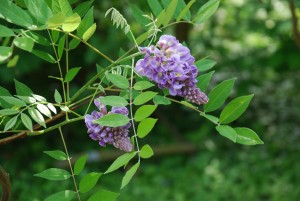Why doesn’t my wisteria (Wisteria spp.) or climbing hydrangea (Hydrangea anomala subsp. petiolaris) vine bloom? There are primarily four (4) reasons why these vines have not flowered. In order of importance they include:
1. The flower buds, which usually formed on the previous summer’s wood, may have been pruned off. Do not prune vine after July 1st as it initiates next spring’s floral buds at this time.
2. Vine may have been over-fertilized, particularly too much nitrogen. Japanese (W. floribunda) and Chinese (W. sinensis) wisterias, as well as our less aggressive U.S. native species (W. frutescens), rarely require feeding. Wisterias gather all they need from any ordinary well-drained soil. Fertilized wisterias, particularly overfed vines, produce lush stems and foliage at the expense of flower production.
3. In some years flower buds are killed by low winter temperatures or late spring frosts.
4. Age matters. Your vine may not have reached “puberty”, is not mature enough to set flower buds. Hydrangea vines grown from cuttings often take 5 or more years to reach blooming age. Grafted vines bloom sooner.
To correct a long flowerless wisteria, vertically cut the surface roots within 12 inches of the vine with a sharp spade. Do this in May or June before flower bud initiation begins in July. This will unduly stress the vine by damaging the roots and likely cause the wisteria to induce flower buds for next spring.


 Posted in
Posted in 
